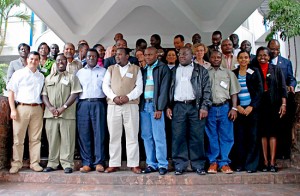(Given in El Batán, Mexico, on 15 September 2009.)
Today we come together to celebrate the 199th anniversary of Mexico’s independence but it is also the saddest moment in the history of CIMMYT, since we are mourning Dr. Borlaug. I am sure, if we could ask him, Dr. Borlaug would insist that we celebrate “El Grito” today. He knew the importance of this tradition, for he not only lived 62 years in Mexico, he loved Mexico, the Mexican people, and Ciudad Obregon, which he considered home.
Dr. Borlaug influenced the thinking of thousands of agricultural scientists. He was the most influential breeder ever and, equally important, his stature enabled him to influence politicians and leaders around the world. His legacy and his work ethic––to get things done and not mind getting your hands dirty––are the basis of Borlaug’s philosophy, which influenced us all and remains CIMMYT’s guiding principle today. He was a giant, a global leader in agriculture, a visionary and, at the same time, very down to earth. In Germany we have the word “Uebervater”––father above all fathers––which best describes what he meant to us and to millions of people.
Over the years, thousands of trainees sweated side by side with Dr. Borlaug in the field. Irrespective of their cultural background, they were infected with the Borlaug bacillus to work together to help others. This core of young scientists became his troops in fighting hunger. Many later became leaders in their own countries, where they implemented Norm’s life philosophy: Don’t be afraid, do your best, never give up, and you will succeed. Training young people was always at the center of his heart. The last time I saw him in Obregon in March, he specifically mentioned that CIMMYT should start in-service training again. Norm, we take this as an order.
Yes, he was a giant, but people at CIMMYT who worked with him will remember Norm as a caring and engaging person. When I was a young man working in Turkey, he called me into his office and asked me how zinc research was progressing. I had just started explaining when he had to leave unexpectedly. One year later, we met again, and he immediately said, “Well, Hans, last year you didn’t tell me the zinc story, so tell me now!” How could he have remembered after one year?
But my most memorable meeting with Norm was in 2005, at the 7th IWC, when I just had been appointed Wheat Program Director. After the conference dinner, at 11:30 pm, he asked me to come to his room, where we talked until 2:30 in the morning. He gave me a lot of advice, some very personal. But two things I can share. One: never, ever, hurt people’s dignity and pride, and never be arrogant. And the other: he said, “I’ll help you!” And help he did. Without his advice, I’m not sure what the Wheat Program would look like today, but for sure not as strong as it is now.
This is how Dr. Borlaug led his life. His generosity affected millions. We will greatly miss his intellectual inspiration, his leadership, and his support. The world has lost one of the greatest human beings ever, and all who knew him should be immensely grateful.
When he talked to Art Klatt and Bill Raun about nitrogen sensor technology, Dr. Borlaug’s parting words were: “Take it to the farmers.” I think these words best summarize what Dr. Borlaug stood for. Farmers––poor farmers and their families––were always in his thoughts. And I promise this was, is, and will remain CIMMYT’s ultimate goal. If we fail in this, we fail in everything we do, and we will not pay Norman Borlaug the tribute he deserves.
 A workshop on media handling and science communication was held for spokespersons of the
A workshop on media handling and science communication was held for spokespersons of the